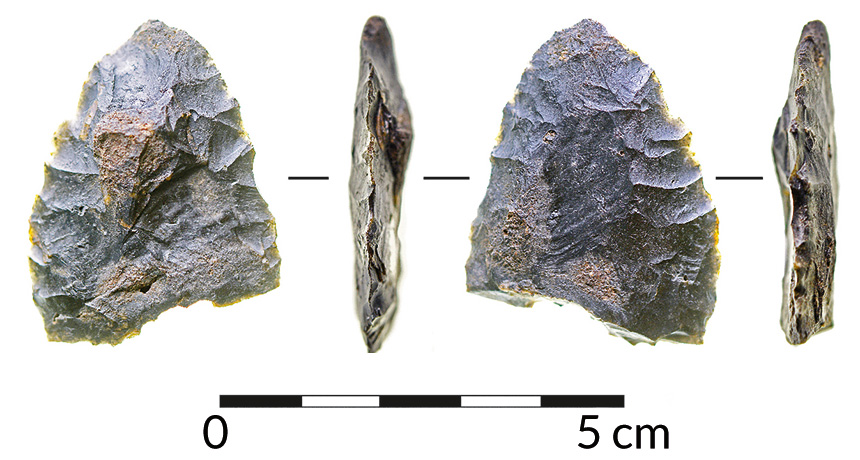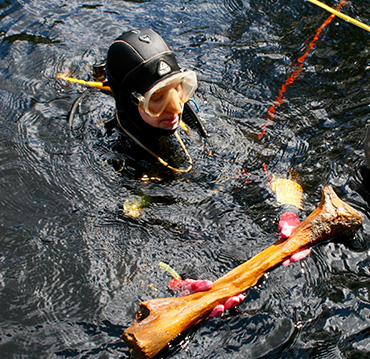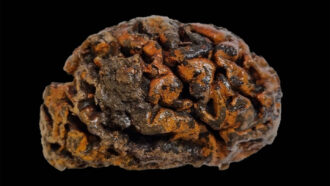Hunter-gatherers roamed Florida 14,500 years ago
Dating of stone tools adds to evidence for early inhabitants in North America

This stone artifact, shown from different angles, was excavated from a submerged site in Florida. This and other evidence shows that people lived there 14,550 years ago.
CSFA
By Bruce Bower
A group of Stone Age people butchered a mastodon — or at least scavenged its carcass — some 14,550 years ago. These were hunter-gatherers that lived on what is now Florida’s Gulf Coast. Researchers discovered their stone tools in an underwater sinkhole. The finds may help scientists resolve when humans first came to the Americas.
For much of the 20th century, scientists thought that the first people to inhabit North America were the Clovis. These people showed up in North America roughly 13,000 years ago. They were named for their distinctive stone tools, found near Clovis, N.M. But evidence has been mounting that the Clovis were not the first North Americans.
Jessi Halligan is an archaeologist at Florida State University in Tallahassee. Michael Waters is an archaeologist at Texas A&M University in College Station. The two led a team that recovered artifacts from a sinkhole in the Aucilla River. This place is known as the Page-Ladson site. And long ago, it was dry land.

The team reported its findings May 13 in Science Advances.
From 2012 to 2014, the team uncovered materials at the site. These included animal bones, too. Those bones indicated that the ancient hunter-gatherers lived next to mastodons, bison and other large creatures for about 2,000 years. These big animals died out roughly 12,600 years ago.
The Page-Ladson site “is one of the best cases for pre-Clovis archaeology in the Americas,” concludes Vance Holliday. He is an archaeologist who works at the University of Arizona in Tucson.
There had been doubts about pre-Clovis people
The new discovery lines up with growing evidence that people crossed a land bridge connecting northeastern Asia to what is now Alaska. They did this around 23,000 years ago. People entered the Americas through this bridge perhaps 18,000 to 16,000 years ago.
From 15,000 to 14,000 years ago, people explored and settled many parts of the Americas. Evidence of hunter-gatherers from that time includes sites in Oregon, Texas and the South American country of Chile. Those discoveries have chipped away at the view that the Clovis people were the first Americans. But some researchers had questioned whether these sites were as old as had been reported.
Previous pre-Clovis finds at Page-Ladson had come under fire, too. Underwater investigations of the Florida site took place from 1983 to 1997. They yielded eight stone artifacts. Also retrieved there: a mastodon tusk. It displayed parallel grooves possibly made by people wielding stone tools. An initial radiocarbon date showed that these finds were about 14,400 years old. But several researchers challenged not only this, but also the proposal that people had butchered the mastodon.
The new discoveries identify Page-Ladson as a “slam-dunk pre-Clovis site,” Waters now says.
In addition, a reexamination of grooves on the mastodon tusk shows that tool users probably made those marks while removing the tusk from the animal’s skull. Study coauthor Daniel Fisher conducted the analysis of that tusk. He is a paleontologist at the University of Michigan in Ann Arbor. Fisher suspects Page-Ladson people sought edible tissue at the tusk’s base and in its inner cavity. They also may have used the tusk’s ivory for weapons.
Florida’s pre-Clovis people probably had plenty of opportunity to hunt or scavenge the remains of such creatures. Sporormiella is a type of fungus found in the dung of plant-eating animals. And high concentrations of Sporormiella spores turned up in several submerged sediment layers. That points indirectly to mastodons and other now-extinct animals as inhabiting Florida’s Gulf Coast at the same time as pre-Clovis people. No signs of Sporormiella appear in sediment dated at about 12,600 years old. That’s roughly the time when researchers suspect many large North American animals died out.
These data do not necessarily mean that people abandoned this region at that point. From mastodons to shellfish, Pre-Clovis groups ate whatever was available and however they could get it, explains James Adovasio. He is an archaeologist at Florida Atlantic University Harbor Branch in Fort Pierce. Ancient Americans adapted to one habitat after another as they moved relatively quickly through North and South America, he says.
For now, Adovasio says, it’s too early to say whether pre-Clovis folk in Florida died out or were ancestors of the later Clovis people.
Power Words
(for more about Power Words, click here)
archaeology (also archeology) The study of human history and prehistory through the excavation of sites and the analysis of artifacts and other physical remains. Those remains can range from housing materials and cooking vessels to clothing and footprints. People who work in this field are known as archaeologists.
artifact An object made by people.
Clovis people Prehistoric humans who inhabited much of North America between about 13,000 and 12,600 years ago. They are known primarily by the cultural artifacts they left behind, especially a type of stone point used on hunting spears. It’s called the Clovis point. It was named after Clovis, New Mexico, where someone first found this type of stone tool.
dung The feces of animals, also known as manure.
fungus (plural: fungi) One of a group of single- or multiple-celled organisms that reproduce via spores and feed on living or decaying organic matter. Examples include mold, yeasts and mushrooms.
hunter-gather A cultural group that feeds itself through hunting, fishing and gathering wild produce (such as nuts, seeds, fruits, leaves, roots and other edible plant parts). They can be somewhat nomadic and do not rely on agriculture for their foodstuffs.
land bridge A narrow region of land linking two large masses of land. In prehistoric times, a major land bridge connected Asia and North America across the Bering Strait. Scientists believe early humans and other animals used it to migrate between the continents.
mastodon A type of extinct mammal belonging to the genus Mammut. These animals looked similar to an elephant covered in fur, and are distantly related to modern-day elephants.
paleontology The branch of science concerned with ancient, fossilized animals and plants. The scientists who study them are known as paleontologists.
radioactive An adjective that describes unstable elements, such as certain forms (isotopes) of uranium and plutonium. Such elements are said to be unstable because their nucleus sheds energy that is carried away by photons and/or and often one or more subatomic particles. This emission of energy is by a process known as radioactive decay.
radiocarbon dating A process to determine the age of material from a once-living object. It is based on comparing the relative proportion, or share, of the carbon-12 to carbon-14. This ratio changes as radioactive carbon-14 decays and is not replaced.
scavenge To collect something useful from what had been discarded as waste or trash.
scuba diving A form of underwater diving in which the person carries special equipment in order to breathe, including a tank of air and a breathing mask. The word scuba is short for self-contained underwater breathing apparatus.
sediment Material (such as stones and sand) deposited by water, wind or glaciers.
sinkhole A body of water that forms when a patch of ground opens up, revealing a rocky cavern below. That rocky structure then accumulates rainwater because there no opening below that allows the water to easily exit. Some sinkholes develop naturally. Others can result from the over-pumping of any groundwater that may have collected in the rocky underground cavern. Sinkholes can be as small as a meter across or as large as a big lake.
Stone Age A prehistoric period when weapons and tools were made of stone or of materials such as bone, wood, or horn. This period lasted millions of years and came to an end around 10,000 to 12,000 years ago.







